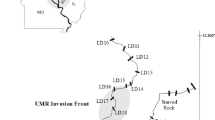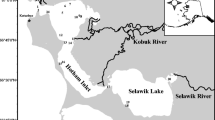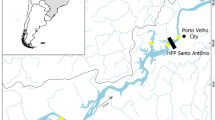Abstract
Asian carps continue to expand their range in North America, necessitating efforts to limit the spread and establishment of reproducing populations. Mississippi River Lock and Dam 19 is a high-head dam that represents a population ‘pinch-point’ as passage through the lock chamber is the only means by which fishes can complete upstream movement. As such, this location could be a pivotal control point for minimizing the spread of invasive fishes in the Upper Mississippi River and a possible candidate site for installation of deterrent measures. Our objectives were (1) to study the timing (i.e., weekly and diel) and behavior of fishes in the downstream lock approach, (2) evaluate the relation of presence in the downstream lock approach with environmental factors and lock operation, and (3) identify any upstream or downstream passage events through the lock chamber and the relation between these events and the operation of the lock. Acoustic transmitters were surgically implanted into 262 Asian carps and 216 native fishes to monitor fish activity on a telemetry receiver array deployed around and within the lock for 622 days during 2017–2018. One hundred eighty-six telemetered fish were detected in the downstream lock approach. We documented 14 upstream Asian carp passages and 10 upstream native fish passages; these passages coincided with a specific sequence of large vessel lockages. The results of this study advance our understanding of fish presence and behavior at a Mississippi River mainstem lock and dam and inform the development and testing of deterrent systems at this location or at similar pinch-point lock and dams.




Similar content being viewed by others
Availability of data and material
All data available on ScienceBase https://doi.org/10.5066/P9HOPS3O.
Code availability
Code available through USGS code release.
References
Akaike H (1973) Information theory and an extension of the maximum likelihood principle. In: Petrov BN, Casaki F (eds) Second international symposium on information theory. Akademiai Kiado, Budapest, Hungary, pp 267–281
Asian Carp Regional Coordinating Committee (2015) Asian carp monitoring and response plan interim summary report. http://asiancarp.us/Documents/InterimSummary2015.pdf
Asian Carp Regional Coordinating Committee (2016) Asian carp monitoring and response plan interim summary report. http://asiancarp.us/Documents/InterimSummary2016.pdf
Asian Carp Regional Coordinating Committee (2018) Asian carp action plan for fiscal year 2018. http://www.asiancarp.us/documents/2017ActionPlan.pdf
Asian Carp Regional Coordinating Committee (2020) Asian carp action plan 2020. https://www.asiancarp.us/Documents/2020-Action-Plan.pdf
Barton K (2019) MuMIn: multi-model inference. In: CRAN R Proj. https://cran.r-project.org/web/packages/MuMIn/index.html. Accessed 15 May 2019
Bhowmik NG (1991) Commercial navigation in large rivers and the development of appropriate management alternatives. In: Hydrology for the water management of large river basins (Proceedings of the Vienna Symposium). pp 93–103
Brooks ME, Kristensen K, van Benthem KJ et al (2017) glmmTMB balances speed and flexibility among packages for zero-inflated generalized linear mixed modeling. R J 9:378–400
Burnham KP, Anderson DR (2002) Model selection and multi-model inference: a practical information-theoretic approach, 2nd edn. Springer, New York
Butler SE, Porreca AP, Collins SF et al (2018) Does fish herding enhance catch rates and detection of invasive bigheaded carp? Biol Invasions. https://doi.org/10.1007/s10530-018-1857-2
Campbell HA, Watts ME, Dwyer RG, Franklin CE (2012) V-Track: software for analysing and visualising animal movement from acoustic telemetry detections. Mar Freshw Res 63:815–820. https://doi.org/10.1071/MF12194
Cohen J (1960) A coefficient of agreement for nominal scales. Educ Psychol Meas 20:37–46
Coker RE (1929) Keokuk Dam and the fisheries of the Upper Mississippi River. Bull Bur Fish 45:87–139
Conover G, Simmonds R, Whalen M (2007) Management and control plan for bighead, black, grass and silver carps in the United States. Aquatic Nuisance Species Task Force, Asian Carp Working Group, Washington, DC
Coulter AA, Keller D, Amberg JJ et al (2013) Phenotypic plasticity in the spawning traits of bigheaded carp (Hypophthalmichthys spp.) in novel ecosystems. Freshw Biol 58:1029–1037. https://doi.org/10.1111/fwb.12106
Coulter AA, Bailey EJ, Keller D, Goforth RR (2016) Invasive Silver Carp movement patterns in the predominantly free-flowing Wabash River (Indiana, USA). Biol Invasions 18:471–485. https://doi.org/10.1007/s10530-015-1020-2
Coulter AA, Brey MK, Lubejko M et al (2018) Multistate models of bigheaded carps in the Illinois River reveal spatial dynamics of invasive species. Biol Invasions. https://doi.org/10.1007/s10530-018-1772-6
Cupp AR, Erickson RA, Fredricks KT et al (2016) Responses of invasive silver and bighead carp to a carbon dioxide barrier in outdoor ponds. Can J Fish Aquat Sci 74:297–305. https://doi.org/10.1139/cjfas-2015-0472
Darling JA, Mahon AR (2011) From molecules to management: adopting DNA-based methods for monitoring biological invasions in aquatic environments. Environ Res 111:978–988. https://doi.org/10.1016/j.envres.2011.02.001
Das SN, Das SK, Kariya JN (2012) Simulation of return flow in restricted navigation channel for barge-tow movements. Open Ocean Eng J 5:34–46. https://doi.org/10.2174/1874835x01205010034
DeBoer JA, Anderson AM, Casper AF (2018) Multi-trophic response to invasive silver carp (Hypophthalmichthys molitrix) in a large floodplain river. Freshw Biol. https://doi.org/10.1111/fwb.13097
Dextrase AJ, Mandrak NE (2006) Impacts of alien invasive species on freshwater fauna at risk in Canada. Biol Invasions 8:13–24. https://doi.org/10.1007/s10530-005-0232-2
Dormann CF, Elith J, Bacher S et al (2013) Collinearity: a review of methods to deal with it and a simulation study evaluating their performance. Ecography 36:27–46. https://doi.org/10.1111/j.1600-0587.2012.07348.x
Eakin WW (2017) Handling and tagging effects, in-river residence time, and postspawn migration of anadromous river herring in the Hudson River, New York. Mar Coast Fish 9:535–548. https://doi.org/10.1080/19425120.2017.1365785
Finger JS, Riesgraf AT, Zielinski DP, Sorensen PW (2019) Monitoring upstream fish passage through a Mississippi River lock and dam reveals species differences in lock chamber usage and supports a fish passage model which describes velocity-dependent passage through spillway gates. River Res Appl. https://doi.org/10.1002/rra.353
FishPro Consulting Engineers and Scientists (2004) Feasibility study to limit the invasion of Asian carp into the Upper Mississippi River basin. http://files.dnr.state.mn.us/natural_resources/invasives/aquaticanimals/asiancarp/umrstudy.pdf
Frank HJ, Mather ME, Smith JM et al (2009) What is “fallback”?: metrics needed to assess telemetry tag effects on anadromous fish behavior. Hydrobiologia 635:237–249. https://doi.org/10.1007/s10750-009-9917-3
Fritts AK, Knights BC, Lafrancois TD et al (2018) Evaluating potential effects of bigheaded carps on fatty acid profiles of multiple trophic levels in large rivers of the Midwest, USA. Food Webs
Fritts AK, Knights BC, Milde AS et al (2020) 2017–2018 Telemetry data for Asian carp and native fish species at Lock and Dam 19 in the Upper Mississippi River Basin. https://doi.org/10.5066/P9HOPS3O
García-Berthou E, Alcaraz C, Pou-Rovira Q et al (2005) Introduction pathways and establishment rates of invasive aquatic species in Europe. Can J Fish Aquat Sci 62:453–463. https://doi.org/10.1139/f05-017
Gibson-Reinemer DK, Solomon LE, Pendleton RM et al (2017) Hydrology controls recruitment of two invasive cyprinids: bigheaded carp reproduction in a navigable large river. PeerJ. https://doi.org/10.7717/peerj.3641
Hayer C-A, Graeb BDS, Bertrand KN (2014) Adult, juvenile and young-of-year bighead, Hypophthalmichthys nobilis (Richardson, 1845) and silver carp, H. molitrix (Valenciennes, 1844) range expansion on the northwestern front of the invasion in North America. BioInvasions Rec 3:283–289. https://doi.org/10.3391/bir.2014.3.4.10
Hinterthuer A (2012) The explosive spread of Asian carp. Bioscience 62:220–224. https://doi.org/10.1525/bio.2012.62.3.3
Hosmer D, Lemeshow S (2000) Applied logistic regression, 2nd edn. Wiley, New York
Jackson N, Runstrom AL (2018) Upper Mississippi river basin Asian carp control strategy framework. Upper Mississippi River Asian carp partnership. Upper Mississippi River Conservation Committee Fisheries Technical Section, Marion
Jennings DP (1988) Bighead carp (Hypophthalmichthys nobilis): a biological synopsis. Biol. Rep. U.S. Fish and Wildlife Service, Washington, DC
Jennings CA, Zigler SJ (2000) Ecology and biology of paddlefish in North America: historical perspectives, management approaches, and research priorities. Rev Fish Biol Fish 10:167–181. https://doi.org/10.1023/A:1016633604301
Kim J, Mandrak NE (2016) Assessing the potential movement of invasive fishes through the Welland Canal. J Great Lakes Res 42:1102–1108. https://doi.org/10.1016/j.jglr.2016.07.009
Kolar CS, Chapman DC, Courtenay WRJ et al (2007) Bigheaded Carps: a biological synopsis and environmental risk assessment. American Fisheries Society, Bethesda
Landis JR, Koch GG (1977) The measurement of observer agreement for categorical data. Biometrics 33:159–174
Larson JH, Knights BC, McCalla SG et al (2017) Evidence of Asian carp spawning upstream of a key choke point in the Mississippi River. N Am J Fish Manag 37:903–919. https://doi.org/10.1080/02755947.2017.1327901
LeRoy JZ, Davis JJ, Shanks MR et al (2019) Efficacy of increasing discharge to reduce tow-mediated fish passage across an electric dispersal barrier system in a confined channel. J Great Lakes Res. https://doi.org/10.1016/j.jglr.2019.08.007
Liu M, Lin J, Peng Q et al (2018) Relationship between the distribution of broodstock and vorticity of spawning grounds of four major Chinese carps in the middle reaches of the Yangtze River during ecological operation of the Three Gorges Dam. Water 10:1487. https://doi.org/10.3390/w10101487
Lodge DM, Simonin PW, Burgiel SW et al (2016) Risk analysis and bioeconomics of invasive species to inform policy and management. Annu Rev Environ Resour 41:453–488. https://doi.org/10.1146/annurev-environ-110615-085532
Lubejko MV, Whitledge GW, Coulter AA et al (2017) Evaluating upstream passage and timing of approach by adult bigheaded carps at a gated dam on the Illinois River. River Res Appl 33:1268–1278. https://doi.org/10.1002/rra.3180
Lucas MC, Baras E (2001) Migration of freshwater fishes. Blackwell Science, Oxford
MacNamara R, Glover D, Garvey J et al (2016) Bigheaded carps (Hypophthalmichthys spp.) at the edge of their invaded range: using hydroacoustics to assess population parameters and the efficacy of harvest as a control strategy in a large North American river. Biol Invasions 18:3293–3307. https://doi.org/10.1007/s10530-016-1220-4
Mazumder BS, Bhowmik NG, Soong TW (1993) Turbulence in rivers due to navigation traffic. J Hydraul Eng 119:581–597
Mississippi Interstate Cooperative Resource Association (2018) Monitoring and response plan for Asian Carp in the Mississippi River Basin. http://micrarivers.org/wp-content/uploads/2018/10/2018-Monitoring-and-Response-Plan-for-Asian-carp-in-the-Mississippi-River-Basin.pdf. Accessed 8 Feb 2019
Mitchell AJ, Kelly AM (2006) The public sector role in the establishment of grass carp in the United States. Fisheries 31:113–121
Moen CT, Scarnecchia DL, Ramsey JS (1992) Paddlefish movements and habitat use in pool 13 of the upper Mississippi River during abnormally low river stages and discharges. N Am J Fish Manag 12:744–751. https://doi.org/10.1577/1548-8675(1992)012<0744:pmahui>2.3.co;2
Murchy KA, Cupp AR, Amberg JJ et al (2017) Potential implications of acoustic stimuli as a non-physical barrier to silver carp and bighead carp. Fish Manag Ecol 24:208–216. https://doi.org/10.1111/fme.12220
Nico LG, Williams JD, Jelks HL (2005) Black carp biological synopsis and risk assessment of an introduced fish. American Fisheries Society, Bethesda
Noatch MR, Suski CD (2012) Non-physical barriers to deter fish movements. Environ Rev 20:71–82. https://doi.org/10.1139/a2012-001
Parker AD, Glover DC, Finney ST et al (2015) Direct observations of fish incapacitation rates at a large electrical fish barrier in the Chicago Sanitary and Ship Canal. J Great Lakes Res 41:396–404. https://doi.org/10.1016/j.jglr.2015.03.004
Pearson K (1900) On the criterion that a given system of deviations from the probable in the case of a correlated system of variables is such that it can be reasonably supposed to have arisen from random sampling. Lond Edinb Dublin Philos Mag J Sci 50:157–175
Pendleton RM, Schwinghamer C, Solomon LE, Casper AF (2017) Competition among river planktivores: Are native planktivores still fewer and skinnier in response to the Silver Carp invasion? Environ Biol Fishes 100:1213–1222. https://doi.org/10.1007/s10641-017-0637-7
Pflieger WL (1997) The fishes of Missouri, 2nd edn. Conservation Commission of the State of Missouri, Jefferson City
Phelps QE, Tripp SJ, Bales KR et al (2017) Incorporating basic and applied approaches to evaluate the effects of invasive Asian Carp on native fishes: a necessary first step for integrated pest management. PLoS ONE 12:e0184081. https://doi.org/10.1371/journal.pone.0184081
Poulton BC, Kroboth PT, George AE et al (2019) First examination of diet items consumed by wild-caught black carp (Mylopharyngodon piceus) in the U.S. Am Midl Nat 182:89–108
Prada AF, George AE, Stahlschmidt BH et al (2020) Influence of turbulence and in-stream structures on the transport and survival of grass carp eggs and larvae at various developmental stages. Aquat Sci. https://doi.org/10.1007/s00027-019-0689-1
Prechtel AR, Coulter AA, Etchison L et al (2018) Range estimates and habitat use of invasive Silver Carp (Hypophthalmichthys molitrix): evidence of sedentary and mobile individuals. Hydrobiologia 805:203–218. https://doi.org/10.1007/s10750-017-3348-3
Priegel GR, Wirth TL (1974) The lake sturgeon, its life history, ecology, and management
Putland RL, Mensinger AF (2019) Acoustic deterrents to manage fish populations. Rev Fish Biol Fish. https://doi.org/10.1007/s11160-019-09583-x
Pyšek P, Richardson DM (2010) Invasive species, environmental change and management, and health. Annu Rev Environ Resour 35:25–55. https://doi.org/10.1146/annurev-environ-033009-095548
R Core Team (2019) R: a language and environment for statistical computing
Radinger J, Wolter C (2014) Patterns and predictors of fish dispersal in rivers. Fish Fish 15:456–473. https://doi.org/10.1111/faf.12028
Rahel FJ (2013) Intentional fragmentation as a management strategy in aquatic systems. Bioscience 63:362–372. https://doi.org/10.1525/bio.2013.63.5.9
Rahel FJ, McLaughlin RL (2018) Selective fragmentation and the management of fish movement across anthropogenic barriers. Ecol Appl 28:2066–2081. https://doi.org/10.1002/eap.1795
Rogers M, Fiss F, Morris J, Hickey C (2018) Deterrent strategy planning for Asian carp in the Ohio River Basin. In: Ohio River Basin Annu. Summ. Rep. http://www.micrarivers.org/wp-content/uploads/2019/06/2018-TNCR-Deterrents-AIR.pdf
Royall RM (1997) Statistical evidence: a likelihood paradigm. Chapman and Hall, New York
Russell TR (1986) Biology and life history of the paddlefish: a review. In: Dillard JG, Graham LK, Russell TR (eds) The paddlefish: status, management, and propagation. American Fisheries Society, Bethesda, pp 2–20
Sampson SJ, Chick JH, Pegg MA (2009) Diet overlap among two Asian carp and three native fishes in backwater lakes on the Illinois and Mississippi rivers. Biol Invasions 11:483–496. https://doi.org/10.1007/s10530-008-9265-7
Silva AT, Lucas MC, Christos TC et al (2018) The future of fish passage science, engineering, and practice. Fish Fish. https://doi.org/10.1111/faf.12258
Sing T, Sander O, Beerenwinkel N, Lengauer T (2005) ROCR: visualizing classifier performance in R. Bioinformatics 21:3940–3941
Solomon LE, Pendleton RM, Chick JH, Casper AF (2016) Long-term changes in fish community structure in relation to the establishment of Asian carps in a large floodplain river. Biol Invasions 18:2883–2895. https://doi.org/10.1007/s10530-016-1180-8
Sullivan CJ, Weber MJ, Pierce CL, Camacho CA (2020) A comparison of Grass Carp population characteristics upstream and downstream of Lock and Dam 19 of the Upper Mississippi River. J Fish Wildl Manag. https://doi.org/10.3996/062019-JFWM-046
Taylor RM, Pegg MA, Chick JH (2005) Response of bighead carp to a bioacoustics behavioral fish guidance system. Fish Manag Ecol 12:283–286
Theiling CH, Nestler JM (2010) River stage response to alteration of Upper Mississippi River channels, floodplains, and watersheds. Hydrobiologia 640:17–47. https://doi.org/10.1007/s10750-009-0066-5
Tripp S, Brooks R, Herzog D, Garvey J (2014) Patterns of fish passage in the Upper Mississippi River. River Res Appl 30:1056–1064. https://doi.org/10.1002/rra
Upper Mississippi River Asian Carp Partnership (2018) Potential use of deterrents to manage Asian carp in the upper Mississippi River basin. http://www.micrarivers.org/wp-content/uploads/2019/08/Potential-Use-of-Deterrents_Final.pdf
U.S. Army Corps of Engineers (1981) Upper Mississippi River basin master reservoir regulation manual, appendix 19, Lock & Dam No. 19. U.S. Army Corps of Engineers, Rock Island
U.S. Army Corps of Engineers (2017) Lock 19. https://www.mvr.usace.army.mil/Missions/Navigation/Lock-and-Dam-Information/Lock-19/
U.S. Geological Survey (2019) Nonindigenous aquatic species database. https://nas.er.usgs.gov/. Accessed 2 Aug 2019
Vetter BJ, Cupp AR, Fredricks KT et al (2015) Acoustical deterrence of Silver Carp (Hypophthalmichthys molitrix). Biol Invasions 17:3383–3392. https://doi.org/10.1007/s10530-015-0964-6
Vetter BJ, Casper AF, Mensinger AF (2017a) Characterization and management implications of silver carp (Hypophthalmichthys molitrix) jumping behavior in response to motorized watercraft. Manag Biol Invasions 8:113–124. https://doi.org/10.3391/mbi.2017.8.1.11
Vetter BJ, Murchy KA, Cupp AR et al (2017b) Acoustic deterrence of bighead carp (Hypophthalmichthys nobilis) to a broadband sound stimulus. J Great Lakes Res 43:163–171. https://doi.org/10.1016/j.jglr.2016.11.009
Wang Z, Wu Q, Zhou J et al (2003) Silver carp, Hypophthalmichthys molitrix, in the Poyang Lake belong to the Ganjiang River population rather than the Changjiang River. Environ Biol Fishes 68:261–267
Weber C, Nilsson C, Lind L et al (2013) Winter disturbances and riverine fish in temperate and cold regions. Bioscience 63:199–210. https://doi.org/10.1525/bio.2013.63.3.8
Whitledge GW, Knights B, Vallazza J et al (2019) Identification of Bighead Carp and Silver Carp early-life environments and inferring Lock and Dam 19 passage in the Upper Mississippi River: insights from otolith chemistry. Biol Invasions 21:1007–1020. https://doi.org/10.1007/s10530-018-1881-2
Wilcox DB, Stefanik EL, Kelner DE et al (2004) Improving fish passage through navigation dams on the upper Mississippi River system. Interim Rep. Up. Mississippi River—Illinois Waterw. Syst. Navig. Study, U.S. Army Corps Eng
Winter JD (1996) Advances in underwater biotelemetry. In: Fisheries techniques. American Fisheries Society, Bethesda, pp 555–590
Wittmann ME, Jerde CL, Howeth JG et al (2014) Grass carp in the Great Lakes region: establishment potential, expert perceptions, and re-evaluation of experimental evidence of ecological impact. Can J Fish Aquat Sci 71:992–999. https://doi.org/10.1139/cjfas-2013-0537
Wolf MC, Phelps QE, Seibert JR, Tripp SJ (2018) A rapid assessment approach for evaluating silver carp gender. Acta Hydrobiol Sin 42:1081–1083. https://doi.org/10.7541/2018.148
Zielinski DP, Sorensen PW (2016) Bubble curtain deflection screen diverts the movement of both Asian and common carp. N Am J Fish Manag 36:267–276. https://doi.org/10.1080/02755947.2015.1120834
Zigler SJ, Dewey MR, Knights BC et al (2004) Hydrologic and hydraulic factors affecting passage of paddlefish through dams in the Upper Mississippi River. Trans Am Fish Soc 133:160–172. https://doi.org/10.1577/T02-161
Acknowledgements
Funding sources were the U.S. Geological Survey Ecosystems Mission Area Invasive Species Program, Missouri Department of Conservation, and U.S. Fish and Wildlife Service-Water Resources Reform and Development Act grant. We thank Jason Rohweder for creating the map, Doug Appel for completing the range tests, and the U.S. Army Corps of Engineers-Lock Performance Management System for providing the Lock Queue Reports. We thank Richard Erickson, Noah Adams, Mark Cornish, and two anonymous reviewers for providing helpful comments that improved the manuscript. The findings and conclusions in this article do not necessarily represent the views of the U.S. Fish and Wildlife Service. Any use of trade, firm, or product names is for descriptive purposes only and does not imply endorsement by the U.S. Government.
Funding
Funding sources were the U.S. Geological Survey Ecosystems Mission Area Invasive Species Program, Missouri Department of Conservation, and U.S. Fish and Wildlife Service-Water Resources Reform and Development Act grant.
Author information
Authors and Affiliations
Corresponding author
Ethics declarations
Conflict of Interest
The authors declare that they have no conflict of interest.
Ethics approval
USGS Upper Midwest Environmental Sciences Center Animal Care and Use Committee approval.
Additional information
Publisher's Note
Springer Nature remains neutral with regard to jurisdictional claims in published maps and institutional affiliations.
Electronic Supplementary Material
Below is the link to the electronic supplementary material.
Rights and permissions
About this article
Cite this article
Fritts, A.K., Knights, B.C., Stanton, J.C. et al. Lock operations influence upstream passages of invasive and native fishes at a Mississippi River high-head dam. Biol Invasions 23, 771–794 (2021). https://doi.org/10.1007/s10530-020-02401-7
Received:
Accepted:
Published:
Issue Date:
DOI: https://doi.org/10.1007/s10530-020-02401-7




